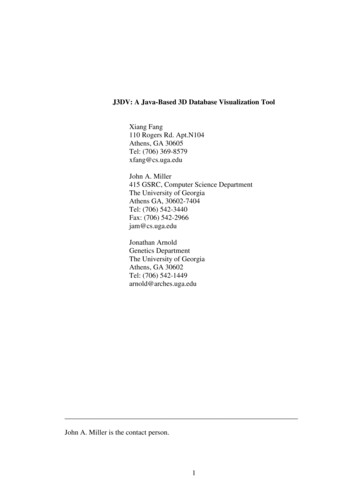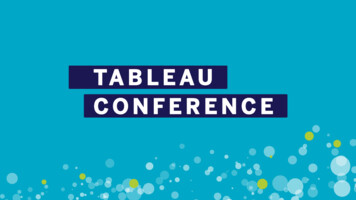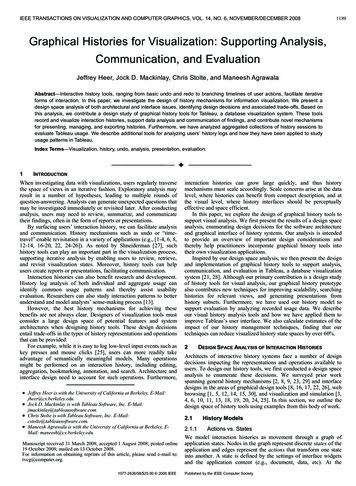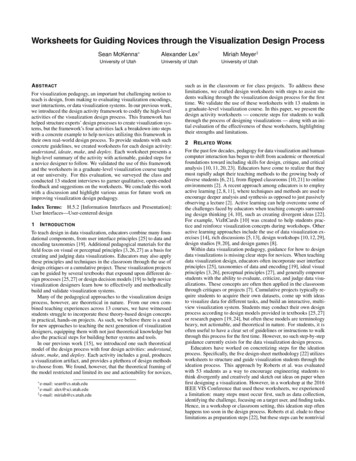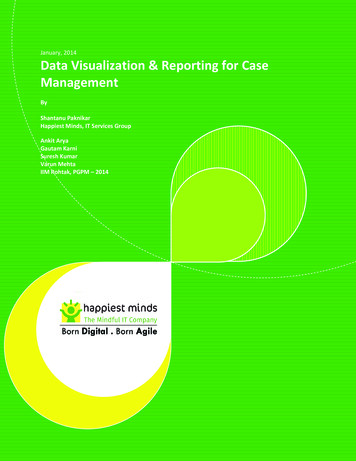
Transcription
1January, 2014Data Visualization & Reporting for CaseManagementByShantanu PaknikarHappiest Minds, IT Services GroupAnkit AryaGautam KarniSuresh KumarVarun MehtaIIM Rohtak, PGPM – 2014 Happiest Minds Technologies Pvt. Ltd. All Rights Reserved
2Table of Contents1. Introduction . 32. Case Management . 53. Key Performance Indicators. 64. Visualization Types. 65. Visualization Examples. 9KPI # 1: Request Withdrawal Rate . 9KPI # 2: Number of customers on-boarded . 10KPI # 3: Process cycle time . 11KPI # 4: Volume Forecast . 12Correlation between KPIs . 136. Conclusion. 147. References . 15 Happiest Minds Technologies. All Rights Reserved
3IntroductionIn the Case Management space, one critical area for helping improve efficiencies of caseworkers is that of analytics and reporting. Generating and presenting case reports based onvarious key performance indicators (KPIs) is critical to empower the case worker to take thebest possible action for resolving the case.Through this paper we have looked at the Customer on-boarding process of the bankingindustry. Our focus was on Customer on-boarding requests (cases) coming in and how theback-office operations for such requests can be optimized. We selected a set of KeyPerformance Indicators (KPI) and looked at how these KPIs will help in Business PerformanceImprovement (BPI) initiatives. To achieve this, we have developed Data Visualization screensusing charts, graphs and other visualizations.Customer on-boardingCustomer on-boarding is the first real experience of the customer with the organization. Itinvolves many important activities, these are depicted in Figure 1.Figure 1: Customer On-Boarding Life Cycle1. Application Filling & Initiation: In most of the banking organizations, the sales/marketerconnects with the client through campaigns etc. and generates leads of the prospects fortheir different products. The client acquisition process begins with application filing &Initiation. The client can use different modes to show their interest for onboarding. Theycan visit the nearest branch or contact the customer care center or visit the bank website Happiest Minds Technologies. All Rights Reserved
4for online application filing. The bank documents the application for the type of productthey are intended for.2. Client checks & validation: Next the dedicated on-boarding team (back office) takesownership of the onboarding request and connects with other departments to processthe request. They do the client checks and verification by gathering client details throughvarious ways. These can include requesting documents for identification such as drivinglicense, passport and checking their validation. Apart from these different compliancechecks are performed depending upon the law of the land.One of these compliance checks could be Anti Money Laundering (AML). They are set oflaws or regulations designed to cease the practice of generating income through illegalways. In most cases money launderers conceal their actions through a series of steps thatmake it look like money coming from illegal or unethical sources was earned legally. InIndia, for instance, AML comes under Prevention of Money Laundering Act, 2002. Themain purpose of this act is to prevent money-laundering as well as to provide forconfiscation of property involved in money-laundering.Background checks are done through KYC (Know your Customer), which is a term usedfor the customer identification process. It involves making adequate efforts to determinetrue identity and beneficial ownership of accounts, the nature of customer’s business,fairness of operations in the account in relation to the customer’s business, source offunds, which in turn helps the banks to manage their risks effectively. The main objectiveof the KYC guidelines is to prevent criminal elements using banks, intentionally orunintentionally for money laundering. KYC basically has two components - Identity andAddress. While the identity remains the same, there may be change in address so thebanks are required to periodically update their records.3. Decision Making: The decision to purchase / clear a financial product is usually driven bymany factors. However, in difficult economic times, it’s important to understand the risksinvolved in the commercial product portfolio. After the authenticity of the customer hasbeen established, decision is taken based on the bank’s policies, rules and regulationsregarding its different products. The decision may include establishing credit limit for thecustomer after performing credit due diligence4. Legal Agreements: Once the decision is made to sell/ offer the product to the client, allthe legal formalities should be completed. These include negotiating legal term,executing legal agreements and completing legal due diligence. These agreements varyas per the requirement of legal system of the country.5. On-boarding: Thereafter, the account is opened in the bank’s core system with theintimation to the customer through welcome pack or calls. The customer can startutilizing the service and begin the product trading. Happiest Minds Technologies. All Rights Reserved
5Case ManagementCase Management is the handling of unstructured ad-hoc and unpredictable processes. Itinvolves human participants and relies on user decisions, actions, events, and policies. CaseManagement can be used to model and address any back-office operations scenario. For thispaper, we have considered a customer on-boarding request as a case that needs to behandled. An on-boarding request is typically for a particular product; request types cantherefore be modeled as per product types.The customer On-boarding process involves different interdependent processes, with uniqueaspects for each request (product) type. Case Management allows better coordination of onboarding activities involving human intervention, resulting in improved efficiencies. CaseData Visualization and Reporting is critical to assist decision making for case workers duringthe on-boarding operations activities.Case Type IdentificationThe major product types in a bank include accounts, cards and loan. With each product typethere can be multiple products, for example, product type card can include products such ascredit card, debit card, travel card etc. In case management, we will have a different casetype for the on-boarding process for each product as depicted in the Figure 2 below.Figure 2: Case Types Happiest Minds Technologies. All Rights Reserved
6Key Performance IndicatorsWe have identified the below 4 KPIs as most relevant in capturing the performance of thecustomer on-boarding process:KPIDescriptionBusiness ImpactVolume ForecastNumber of customers andHelps in better managingvolumeofrequeststhe resources required andforecasted for the nextpredicting future revenuesperiodRequest Withdrawal RatePercentage of customer Identifies the efficiency ofrequestswhichwere the onboarding process inwithdrawn by the customers terms of lost customersProcess Cycle TimeTime elapsed from the pointHelps in identifying thethe request is submitted tobottleneck in the entire onthe point the customer isboarding processon-boardedIdentifies the type ofproduct adding the mostNumber of customers on- Percentage of customersnumber of customers andboardedsuccessfully on-boardedmay help indicating issues inan on-boarding processVisualization TypesData VisualizationThe main purpose of data visualization is to simplify the given data values, promote theunderstanding of them, and communicate important concepts and ideas using the visualmedium. Visualizations help our brains to receive and interpret large amounts of informationin an easy way.Data visualization gives the business users the ability to use information in a simple waywithout deep technical expertise. Data visualization helps to communicate informationclearly and effectively through various graphical means. Happiest Minds Technologies. All Rights Reserved
7Types of VisualizationsOne important aspect in the visualizations is to identify the right type of visualization, whichin turn shall help in interpreting the data in an easy way. The various type of visualizationsfollowed in the report are as follows:1. Pie chartA pie chart is also known as a circle graph. This is divided into sectors, illustratingnumerical proportion. In a pie chart, the arc length of each sector is proportional to thequantity it represents.One disadvantage of pie charts is that it is difficult to compare different sections of agiven pie chart, or to compare data across different pie charts. Pie charts may sometimebe replaced by other plots, for example, Bar Chart.2. Column chart or Bar chartA column chart, also known as a bar chart, is usually represented with rectangular bars oflengths usually proportional to the magnitudes or frequencies of what they represent.The bars can be either horizontally or vertically oriented.The column chart can be further represented in single or multi series with respect to thedata model and the visualization purpose.3. Line chartA chart which displays information as a series of data points which is usually connectedby straight line segments to form a line chart or a line graph. It is a basic typeof chart common in many fields.A line chart is often used to visualize a trend in data over intervals of time, known asa time series. Thus, line charts are often drawn chronologically.4. Tree mapTree mapping is a method for displaying hierarchical data by using nested rectangles.Each branch of the tree is given a rectangle, which is then tiled with smaller rectanglesrepresenting sub-branches. A leaf node's rectangle has an area proportional to aspecified dimension on the data. Often the leaf nodes are colored to show aseparate dimension of the data. Happiest Minds Technologies. All Rights Reserved
8When the color and size dimensions are correlated in some way with the tree structure,one can often easily see patterns that would be difficult to spot in other ways, such as ifa certain color is particularly relevant. A second advantage of tree maps is that, byconstruction, they make efficient use of space. As a result, they can legibly displaythousands of items on the screen simultaneously.5. Scatter chartIn a Scatter chart the data is predominantly displayed as a collection of points. Each pointmay indicate the value of one variable. This variable may in turn determine the positionon the vertical or horizontal axis.From a Scatter chart, correlations between variables can be inferred. A famous examplewould the height and weight plotted on x and y axis respectively.Usually, any Correlation may be positive, negative, or null. In a positive correlation, thepattern of dots is plotted from lower left to upper right. And in a negative correlation it isthe reverse order.6. Network GraphNetwork graph visualization is generally used to plot the directed and the undirectedgraph structures. The graph allows networks to be compared. Also the relationshipbetween entities can be captured in network graph. Happiest Minds Technologies. All Rights Reserved
9Visualization ExamplesKPI # 1: Request Withdrawal RateRequest Withdrawal Rate compares number of requests withdrawn vis-à-vis the number ofrequests received. Visualizations below shows region-wise lost revenue on account ofrequests withdrawn and indicates monthly trends of Request Withdrawal Rate.Figure 3: KPI - Request Withdrawal Rate Happiest Minds Technologies. All Rights Reserved
10KPI # 2: Number of customers on-boardedThis KPI presents hierarchical view of number of customers successfully on-boarded for eachproduct type. The tree-map below shows the classification of each product type into severalproducts, for example, the account product type is classified into saving account, fixeddeposit, current account, salary account and recurring deposit account. The size for eachproduct type in the tree-map is determined by the number of customers successfully onboarded for that product type.Figure 4: KPI - Number of Customers per Product Type Happiest Minds Technologies. All Rights Reserved
11KPI # 3: Process cycle timeThis KPI measures the total time taken for the entire customer on-boarding process. Todepict process cycle time for each product we have used stacked graph showing time takenfor each sub part of the on-boarding process. Also, to compare bank’s process cycle timewith the industry’s we have used side-by-side bar graph for different products offered by thebank.Figure 5: KPI - On-Boarding Process Cycle Time Happiest Minds Technologies. All Rights Reserved
12KPI # 4: Volume ForecastThis KPI helps in predicting the volume of requests and thereby enabling better utilization ofresources. In visualizations we have captured comparison of the forecasted requests with theactual requests and shown the region wise forecast error for each month.Figure 6: Volume Forecast Happiest Minds Technologies. All Rights Reserved
13Correlation between KPIsUsing the scatter plot we were able to find positive correlation between the time taken foron-boarding and request withdrawal rate. This means that if a product had a higher processcycle time, the request withdrawal rate would have been higher. This implies that thenumber of requests withdrawn without being fulfilled by a bank is proportional to the timetaken by it to process the requests. Hence, if a bank is able to reduce the process cycle time,it will able to retain more customers.Figure 7: Negative impact (higher withdrawals) of longer on-boarding Happiest Minds Technologies. All Rights Reserved
14ConclusionA picture is worth a thousand words. Similarly, the value in data can truly be unlocked whenit can be visualized well.In summary, case visualization can result in the following benefits:1. Visualizations enable comparison between variables over time, we could seevariances between forecasted and actual requests using a side by side bar chart.2. Visualizations help in viewing changing trends, for instance depicting requestwithdrawal rate on a line chart over a time period gives an idea of how it haschanged.3. Vast quantities of data can be looked more quickly as it is more representative thandata tables, for example using a tree map we could depict the most popular productsi.e. resulting in the most on-boarding requests.4. Visualizations help achieve more insight into the nature of a problem, we hadrepresented time consumed by different parts of on-boarding process using astacked bar chart and were able to see which process took most time.5. Visualizations help in discovering correlation between variables by usingvisualizations such as Scatter Plot which showed how request withdrawal rateincreases for products with higher process cycle time Happiest Minds Technologies. All Rights Reserved
15References1.2.Tibco Spotfire Application Data -visualization/index.html3. http://en.wikipedia.org/wiki/Data visualization : This website gives an overview of datavisualization and different approaches on the scope of data visualization. One commonfocus is on information presentation, such as Friedman (2008) presented it. In this linethe "Data Visualization: Modern Approaches" (2007) article gives an overview ofdifferent subjects of data visualization.4. ‘Magic Quadrant for Business Intelligence and Analytics Platforms’, www.gartner.com:This document plots different vendors of BI tools on a graph with completion of vision onx-axis and ability to execute on y-axis. It further categorizes the vendors into leaders,challengers, niche player and visionaries based on their positions on the graph. Thisarticle is very useful in comparing different vendors based on their strengths & cautions.5. http://www.tableausoftware.com/ : This website is useful to understand the differenttype of visualizations which are most commonly used in different industries. The whitepapers gives a deeper insight to different types of data visualizations.6. http://stn.spotfire.com/spotfire client help/whnjs.htm: we have used TIBCO Spotfire fordata visualization in this project. The help website and software feature gives detailedinformation of the usage of the software, its different features and using them.7. ‘Client Onboarding: Solving the Challenges, Maximizing the Opportunities’, Fenergowhite paper: This white paper describes what is client on-boarding and measuring clienton boarding. It helped in defining the KPI needed for data visualization.8. ‘Knowledgent Insights’, http://www.knowledgent.com: Knowledgent is a purpose-builtIndustry Information Consultancy that provides advanced Information Management andAnalytical (IM&A) solutions with industry-specific specialization in Financial Services, LifeSciences, Healthcare and Commercial markets. Their white paper ‘Client OnboardingProcess Reengineering: Performance Management of Client Onboarding Programs’ isuseful to get more insights on customer on-boarding9. ‘Client On-boarding and Customer Experience’, http://venkysundaram.wordpress.com :this blog discussions reasons for poor on-boarding experience by the customers whichcan be considered while streamlining the customer on-boarding process.10. http://www.banktech.com/: this website is useful to understand different banking termsand concepts11. http://www.ibm.com12. http://www.investopedia.com/ Happiest Minds Technologies. All Rights Reserved
16About Happiest Minds Technologies:Happiest Minds, the Mindful IT Company, applies agile methodologies to enable digitaltransformation for enterprises and technology providers by delivering seamless customer experience,business efficiency and actionable insights. We leverage a spectrum of disruptive technologies suchas: Big Data Analytics, AI & Cognitive Computing, Internet of Things, Cloud, Security, SDN-NFV, RPA,Blockchain, etc. Positioned as “Born Digital . Born Agile”, our capabilities spans across productengineering, digital business solutions, infrastructure management and security services. We deliverthese services across industry sectors such as retail, consumer packaged goods, edutech, ecommerce, banking, insurance, hi-tech, engineering R&D, manufacturing, automotive and travel/transportation/hospitality.Headquartered in Bangalore, India; Happiest Minds has operations in USA, UK, The Netherlands,Australia and Middle East.Business Contact: business@happiestminds.comMedia Contact: media@happiestminds.comAbout the authorsShantanu Paknikar (shantanu.paknikar@happiestminds.com) is General Manager, Innovative Business Solutionsin the IT Services division of Happiest Minds. His expertise areas include middleware systems, SOA, BPM,enterprise integration, cloud computing, social media, mobility, analytics, multimedia, and distributedcomputing systems. He is passionate about innovation, research, and learning.Ankit Arya (pgp03.071@iimrohtak.ac.in), Gautam Karni (pgp03.027@iimrohtak.ac.in), Suresh Kumar(pgp03.118@iimrohtak.ac.in) and Varun Mehta (pgp03.125@iimrohtak.ac.in)are students of IIM Rohtak,PGPM – 2014.The work on this paper was done during Business Analytics course at IIM Rohtak in collaborationwith Happiest Minds.DISCLAIMER: It may be noted that the authors take full responsibility for the content. IIM Rohtak does notnecessarily subscribe to the views expressed in this paper, which are those of the authors. Happiest Minds Technologies. All Rights Reserved
A line chart is often used to visualize a trend in data over intervals of time, known as a time series. Thus, line charts are often drawn chronologically. 4. Tree map Tree mapping is a method for displaying hierarchical data by using nested rectangles. Each branch of the tree is given a rectangle, which is then tiled with smaller rectangles








